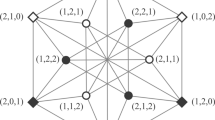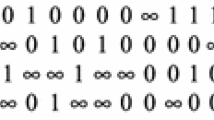Abstract
A covering array CA(N; t, k, v) is an N × k array with entries from a set X of v symbols such that every N × t sub-array contains all t-tuples over X at least once, where t is the strength of the array. The minimum size N for which a CA(N; t, k, v) exists is called the covering array number and denoted by CAN(t, k, v). Covering arrays are used in experiments to screen for interactions among t-subsets of k components. One of the main problems on covering arrays is to construct a CA(N; t, k, v) for given parameters (t, k, v) so that N is as small as possible. In this paper, we present some constructions of covering arrays of strengths 3 and 4 via holey difference matrices with prescribed properties. As a consequence, some of known bounds on covering array number are improved. In particular, it is proved that (1) CAN(3, 5, 2v) ≤ 2v 2(4v + 1) for any odd positive integer v with gcd(v, 9) ≠ 3; (2) CAN(3, 6, 6p) ≤ 216p 3 + 42p 2 for any prime p > 5; and (3) CAN(4, 6, 2p) ≤ 16p 4 + 5p 3 for any prime p ≡ 1 (mod 4) greater than 5.
Similar content being viewed by others
References
Buratti M.: Cyclic designs with block size 4 and related optimal optical orthogonal codes. Des. Codes Cryptogr. 26, 111–125 (2002)
Chang Y., Yin J.: Further results on optimal optical orthogonal codes with weight 4. Discrete Math. 279, 135–151 (2004)
Chateauneuf M., Kreher D.L.: On the state of strength-three covering arrays. J. Combin. Des. 10, 217–238 (2002)
Cohen D.M., Dalal S.R., Fredman M.L., Patton G.C.: The AETG system: an approach to testing based on combinatorial design. IEEE Trans. Software Eng. 23, 437–444 (1997)
Colbourn C.J.: Combinatorial aspects of covering arrays. Le Matematiche (Catania) 58, 121–167 (2004)
Colbourn C.J.: Strength two covering arrays: existence tables and projection. Discrete Math. 308, 772–786 (2008)
Colbourn C.J., Martirosyan S.S., Mullen G.L., Shasha D.E., Sherwood G.B., Yucas J.L.: Products of mixed covering arrays of strength two. J. Combin. Des. 14, 124–138 (2006)
Colbourn C.J., Martirosyan S.S., Trung T.V., Walker R.A., : Roux-type constructions for covering arrays of strengths three and four. Des. Codes Cryptogr. 41, 33–57 (2006)
Drake D.A.: Partial λ-geometries and generalized Hadamard matrices over groups. Can. J. Math. 31, 617–627 (1979)
Hartman A.: Software and hardware testing using combinatorial covering suites. In: Golunbic, M.C., Hartman, I.B.A.(eds) Graph Theory, Combinatorics and Algorithms: Interdisciplinary Applications., pp. 237–266. Springer, Boston (2005)
Hartman A., Raskin L.: Problems and algorithms for covering arrays. Discrete Math. 284, 149–156 (2004)
Hedayat A.S., Slone N.J.A., Stufken J.: Orthogonal Arrays. Springer, New York (1999)
Ji L., Yin J.: Constructions of new orthogonal arrays and covering arrays of strength three, preprint.
Johnson K.A., Entringer R.C.: Largest induced subgraphs of the n-cube that contain no 4-cycles. J. Combin. Theory Ser. B 46, 346–355 (1989)
Körner J., Lucertini M.: Compressing inconsistent data. IEEE Trans. Inform. Theory 40, 706–715 (1994)
Liedl R., Niederreiter H.: Finite Fields. Cambridge University Press, Cambridge (1997)
Martirosyan S., Trung T.V.: On t-covering arrays. Des. Codes Cryptogr. 32, 323–339 (2004)
Poljak S., Putr A., Rödl V.: On qualitatively independent partitions and related problems. Discrete Appl. Math. 6, 193–205 (1983)
Seroussi G., Bshouty N.H.: Vector sets for exhaustive testing of logic circuits. IEEE Trans. Inform. Theory 34, 513–522 (1988)
Stevens B., Mendelsohn E.: New recursive methods for transversal covers. J. Combin. Designs 7, 185–203 (1999)
Tang Y., Yin J.: The combinatorial construction of a class of optimal optical orthogonal codes. Sci. China-A 45, 1268–1275 (2002)
Yin J.: Constructions of difference covering arrays. J. Combin. Theory A 104, 327–339 (2003)
Yin J.: Cyclic difference packing and covering arrays. Des. Codes Cryptogr. 37, 281–292 (2005)
Author information
Authors and Affiliations
Corresponding author
Additional information
Communicated by C.J. Colbourn.
Rights and permissions
About this article
Cite this article
Li, Y., Ji, L. & Yin, J. Covering arrays of strength 3 and 4 from holey difference matrices. Des. Codes Cryptogr. 50, 339–350 (2009). https://doi.org/10.1007/s10623-008-9235-1
Received:
Revised:
Accepted:
Published:
Issue Date:
DOI: https://doi.org/10.1007/s10623-008-9235-1




